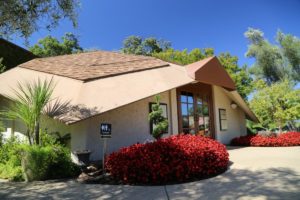
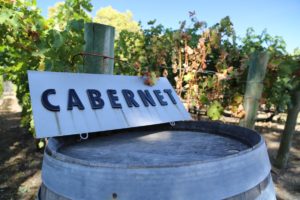
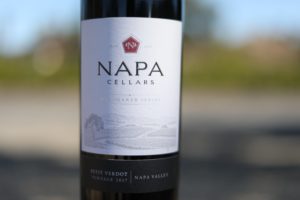 Napa Cellars is located about a 5 minute drive north of Yountville on the west side of Highway 29 directly across the driveway from Piazza del Dotto Winery. It is one of the first few wineries seen as one drives north from the town of Napa and a result of their location often makes a good stop for first time visitors to the valley. As of 2018 the focus of their tastings and sales are exclusively on Napa Cellars produced wines. For several years, prior to 2018, one could try three wine brands associated with the winery including their Napa Cellars (all Napa Valley grapes), Folie à Deux wines and their ever subtlety sexually nuanced – the popular Ménage à Trois wines (California wines). Napa Cellars is owned by Trinchero Family Estates; of all ownership to date, they have owned Napa Cellars the longest.
Napa Cellars is located about a 5 minute drive north of Yountville on the west side of Highway 29 directly across the driveway from Piazza del Dotto Winery. It is one of the first few wineries seen as one drives north from the town of Napa and a result of their location often makes a good stop for first time visitors to the valley. As of 2018 the focus of their tastings and sales are exclusively on Napa Cellars produced wines. For several years, prior to 2018, one could try three wine brands associated with the winery including their Napa Cellars (all Napa Valley grapes), Folie à Deux wines and their ever subtlety sexually nuanced – the popular Ménage à Trois wines (California wines). Napa Cellars is owned by Trinchero Family Estates; of all ownership to date, they have owned Napa Cellars the longest.
A winery in Napa Valley still producing continuously 50+ years after its first vintage is a rare situation; what is even more remarkable is this winery with its generic name has survived six transitions in ownership and three name changes.
We have seen the incorrectly published founding date as 1968 from several sources; even Trinchero Family Estates had both dates listed at times on various parts of their website as the founding years for Napa Cellars. The earliest Napa Wine Cellars bottling we are aware of is a 1973 Sonoma Zinfandel listed in an ad by Marin Wine & Spirits in the San Francisco Examiner dated Tuesday August 22, 1978. We have seen references in newspapers in the late 1970s and 1980s that Napa Wine Cellars was founded in 1972 (possibly their first vintage?). However, most sources indicate the physical winery was completed in 1976, their founding year which is what Trinchero Family Estates now lists on their website.
Other early Napa Cellar wines included a 1975 Napa Valley Riesling and a 1976 Amador County Late Harvest Zinfandel which won a silver medal at the Los Angeles County Fair Wine Competition in 1978, the same year Napa Wine Cellars joined the Wine Institute. Their 1979 Lot-2 won a gold medal in the 1981 Orange County Fair Commercial Wine Competition. Their early Chardonnays were described as being a rich expression of the variety.
The original geodesic building that now serves as the tasting room was built over a span of three years and was bonded in 1975 by vintner Charles R. Woods on 5 acres. Woods was from Great Falls, Montana; his father William was a pharmacist for 50 years including 25 years of running Second Avenue Pharmacy in Great Falls from 1952 through 1977. Charles attended Montana State University for three years and then worked in construction and engineering. According to an article in the Great Falls Tribune dated Sunday June 11, 1978 his grandfather had been a winemaker in France. Heritage must have rubbed off on him as while living in Montana, Charles would make home wine.
According to the same article he and his wife Barbara (she died in 1996) sold their business interests in Montana and moved to California where they purchased a 43-foot sailboat with the intention to sail around the world. They made it as far south as Mexico. Then their plans changed. They moved to San Francisco for the winter of 1972/1973 and started taking many day trips up to Napa Valley.
They sold their boat and purchased the land which would become Napa Cellars. Three acres of Chardonnay was already planted on the property at the time.
In 1977 an exhibit of oil paintings and sculpture by artist Paul Tunkis was held inside the winery. Interestingly, Paul moved to Montana and became a hunting and fishing guide; he continues to paint watercolors from his home base of several decades in Montana.
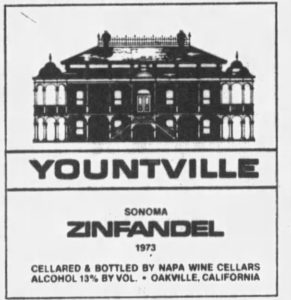 By 1978, Woods brought on several investors from southern California including doctors and lawyers; in 1980 one of the investors purchased Wood’s share of the company. Wood’s left the wine business and moved to Montana to work in construction. Noted local wine writer George Starke and his wife Irma (Bette) were partners in the winery; George was president of the winery for a very short while in the early 1980s. And on a personal note, we have Starke to thank for providing the first ever publicity for the Napa Wine Project in one of his Up and Down the Wine Roads columns in the St. Helena Star. And we feel fortunate to have met his amazing wife before she died at 98 years young.
By 1978, Woods brought on several investors from southern California including doctors and lawyers; in 1980 one of the investors purchased Wood’s share of the company. Wood’s left the wine business and moved to Montana to work in construction. Noted local wine writer George Starke and his wife Irma (Bette) were partners in the winery; George was president of the winery for a very short while in the early 1980s. And on a personal note, we have Starke to thank for providing the first ever publicity for the Napa Wine Project in one of his Up and Down the Wine Roads columns in the St. Helena Star. And we feel fortunate to have met his amazing wife before she died at 98 years young.
The name of the winery was originally Napa Wine Cellars; in 1982 the name was shortened to simply, Napa Cellars. According to an article dated October 20, 1977, in the St. Helena Star, Woods opened the tasting room in 1977. A number of producers made wine at Napa Cellars in the early 1980s including Robert Pepi, Chateau Boswell and Diamond Oaks (their former site is now home to Promonotory Winery). The importer and marketing company, Wilson Daniels was also listed in the early 1980s as either involved in wine production or were making their own brand here. Wines from other brands were also later produced here including Hagafen before they built their own winery.
Napa Cellars has changed hands a number of times; two brothers, Firmin (died in a plane crash in 1987) and Jacques DeSchepper of Gent, Belgium purchased the winery in 1983 from the investors and renamed it to DeMoor Winery in 1986. Napa Cellars became their second label. Their parents Emile de Schepper and Ghislaine de Moor founded a gin and liqueur company in 1938 called Rabotvins. This family owned and operated company is still in business, currently owning several chateau’s in Bordeaux.
A number of winemakers have produced wine here over the decades including Aaron Mosley (died 2019), Don Baker (Sciandri Family) Michael Cox (Schug Winery) and since 2007 as head winemaker, Napa native, Joe Shirley. Mosely was among the early Napa Valley wineries to start bottling some of the wines in synthetic corks in the early 1990s.
Firmin’s death ultimately was the reason that DeMoor Winery was sold in 1990 to a Tokyo, Japan based Sky Court Corporation (Hohkoku Kohsan); this was the company’s first winery purchase. After they took ownership, the wines continued to be distributed around the U.S. but were also exported for sale in Japan. At the time of this transaction, the winery was producing around 18,000 cases of wine annually.
In 1996 Napa Cellars was purchased by two well-known vintner names in the valley: Rich Frank and Koerner Rombauer (Koerner passed away in 2018 and will be sorely missed by many in the valley) both of whom founded other wineries. After their purchase the name for the winery and primary brand was returned to be called Napa Cellars. In 2000 a major wine warehouse fire on the property that is now home to Frank Family destroyed approximately 84,000 cases of wine including the majority of Napa Cellars bottles spanning several vintages and totaling approximately 14,000 cases.
Trinchero Family Estates purchased both the Folie à Deux property and brand in 2004 and Napa Cellars in 2006. The original Folie à Deux property is currently home to Trinchero Family Estates. Until 2018 the Folie à Deux wines were also served and sold at Napa Cellars. Folie à Deux means craziness for two in French); this winery was founded in 1981 by psychiatrist and winemaker Larry Dizmang, his wife Evie and psychologist Gary Mills. The original home of Folie à Deux was an old yellow farmhouse; this used to be the tasting room for Trinchero family until it was eventually torn down, replaced by their current hospitality center.
The Dizmangs produced award winning wines early on; in 1985 their 1983 Napa Valley Chardonnay won gold medal at the San Diego Wine Competition. That same year they also were awarded medals from Harrah’s National Wine Competition and the National Restaurant Association Competition.
A small group of investors purchased Folie à Deux in the mid 1990s from the Dizmang’s including winemaker Dr. Richard Peterson and also Calistoga winery owners, David and Betsy Lawer. Winemaker Scott Harvey was the president and oversaw the winemaking for the company for several years.
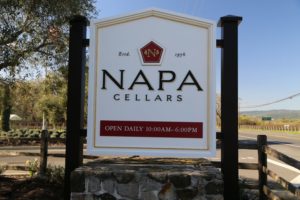
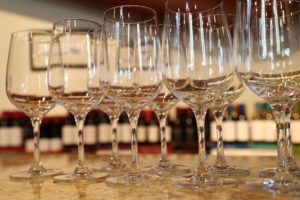
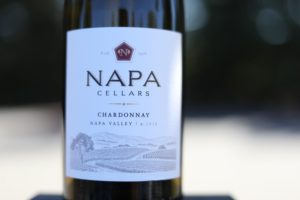 Well into his 90s now, Peterson continues to produce wines from one of the most unique varieties grown in California, the Wrotham clone of Pinot Noir. Over the years he has bottled wines from this clone under the labels Richard Grant and Richard G Peterson. In the early 2000s a wine from these grapes were produced and bottled at Folie à Deux Winery as the Grande Folie Wrotham Pinot Brut.
Well into his 90s now, Peterson continues to produce wines from one of the most unique varieties grown in California, the Wrotham clone of Pinot Noir. Over the years he has bottled wines from this clone under the labels Richard Grant and Richard G Peterson. In the early 2000s a wine from these grapes were produced and bottled at Folie à Deux Winery as the Grande Folie Wrotham Pinot Brut.
Today Folie à Deux wines are no longer available to taste at Napa Cellars and the Folie à Deux brand has transitioned into wines produced only from Sonoma County appellations.
Napa Cellars produces a wide diversity of wines categorized under the Classic Collection, V Collection and the Winemaker Series. The Classic Collection includes their higher volume produced wines which are from Napa Valley and are nationally distributed, the V Collection are wines sourced from specific sub appellations within Napa Valley and are named in tribute of the original five acres on the site of the winery and the Winemaker Series includes very limited production wines from specific sub appellations within Napa Valley.
The tasting counter is located in the nondescript geodesic dome like building right next to St. Helena Highway (Highway 29); the wine tasting is casual & relaxed. Their tasting room in fact used to be the old barrel room and the original brick floor is still in place. If you look carefully, you will notice the floor slopes downwards towards the center of the tasting room which is where the drain was originally located. And if if you know where to look, towards the southeast wall – you will spot an outline in the brick floor of what used to be a bathroom.
Only Napa Valley grown grapes are used in Napa Cellars’ wines. As of our latest update to this review, Napa Cellars sources grapes from three primary vineyards; Vista Montone Vineyard planted to Chardonnay and Pinot Noir is located in the cooler southern part of the valley, Main Street Vineyard is planted to Cabernet Sauvignon and is located in St. Helena and the Salvador Vineyard is also planted to Cabernet Sauvignon and is located in the Oak Knoll District. But the Trinchero family owns many more vineyards in Napa Valley besides this three properties which are additional sources for grapes for Napa Cellars. And the winery has a long term relationship with Antinori Vineyard on Atlas Peak and some of their grapes are sourced from this site.
Select Wines
Napa Cellars makes a variety of reds; these are the wines they are most known for. Several Cabernet Sauvignons are produced, including their much in demand Oakville bottling, which is very reasonably priced for Oakville. In fact, all their wines are quite reasonably priced for Napa Valley standards.
Whites
The 2023 Napa Cellars Napa Valley Sauvignon Blanc was destemmed, pressed and then fermented cold in stainless steel tanks – and was also aged in stainless steel prior to bottling. This wine is pale straw in color. The vibrant and highly attractive bouquet offers a diversity of aromas including of citrus blossom, grapefruit, kaffir lime leaf, honeydew melon, passion fruit and lemongrass. The nose is not overly green or grassy but has just enough herbal characteristics to let you know this is Sauvignon Blanc. On the palate there are flavors of pineapple, white peach, pineapple guava, golden delicious apples, Asian pear, lychee, tangerine and mango. It is not as herbal on the palate as on the nose. Zippy and bone dry, its lightly rounded texture is complemented perfectly with its vibrant but balanced acidity. The finish keeps inviting one back for another sip. We wouldn’t mind pairing this with a bowl of clam chowder from Splash Cafe, enjoying both chowder and wine from the sands of Pismo Beach overlooking the Pacific Ocean on a warm fall day.
The 2023 Napa Cellars Napa Valley Chardonnay was fermented and aged for 7 months in 100% French oak barrels of which 26% were new. This wine went through 100% malolactic fermentation and it’s lees were stirred for the duration of its aging. This wine is medium gold in color; the first aromatic which jumped out of the glass at us was of popcorn butter. Other scents include honeycomb, mottled banana, apricot, ripe pineapple, toasted oak, vanilla and butterscotch. Minerally, with flavors of caramel, butterscotch, vanilla, mandarin orange, yellow peaches, apricot, honeydew melon, hazelnut and notes of lingering toasted oak (but the oak does not dominate). Its rounded and creamy mouth feel is balanced by a rich flavor profile and bright acidity. One of this wine’s hallmarks is its lovely long finish. It keeps on giving. Refreshing, the acidity clocks in at a reasonable 13.5%. We might like to try this with a Crab Louie salad.
The 2018 Napa Cellars Napa Valley Chardonnay is medium to deep gold in color; the bouquet offers aromas of Golden Delicious apple, ripe pear, caramel, warm butter, vanilla and coconut. Its texture is supple and creamy across the palate. This bottling shows flavors of lemon meringue, lemongrass, melon and apple. It lingers with a richness of both fruit and a darker spicy nuance including notes of hazelnut and a toasty oak character. This wine was fermented entirely in barrels of which 27% were new French oak; the grapes came from a variety of southern Napa Valley vineyard sites including in Carneros and in the Oak Knoll District.
Reds
The 2021 Napa Cellars Napa Valley Pinot Noir was aged in 100% French oak of which 30% were new barrels and 70% seasoned barrels. This wine is pale ruby in color; the bouquet delivers plenty of ripe fruit with the fruit dominating over any oak and or varietal spice presence. These aromas include cherry cola, raspberry, cran-apple, Santa Rosa plum and cooked cranberries with hints of graham cracker, Tonka bean, old library book, cardamom and vanilla. We remember who first pointed out the aroma of cardamom sometimes found in Pinot Noir to us; it was Dr. Richard Peterson, years ago when we were tasting his Wrotham Pinot Noir. On the palate, the fruit also dominates with flavors of red cherries, currants, cranberries with some baking spice notes including a lasting presence of cinnamon. The tannins are lightly grainy and persist more on the front of the palate than the back, complemented by both fruit and a balanced acidity. This is a lighter in style and easy drinking wine. If we were to pair this with something, perhaps it would go well with a cream of mushroom soup.
The 2018 Napa Cellars Napa Valley Pinot Noir is pale ruby in color; the first word we wrote after smelling the bouquet was spicy. The aromas include white pepper, raspberry, cherry cola, red licorice, some herbal notes and old cedar box. Balanced across the the palate, this bottling offers flavors of raspberry, red cherry, cranberry and mint. It finishes soft with finely woven lightly structured tannins, toasted oak, a pepper spice, medium acidity and a lingering hint of boiled rhubarb. The finish is savory. This wine was produced from grapes growing in the southern part of Napa Valley (cooler climate) and was aged for 10 months in French of barrels of which 28% was in new oak. This is one of the better quality to price point Pinot Noirs from Napa Valley.
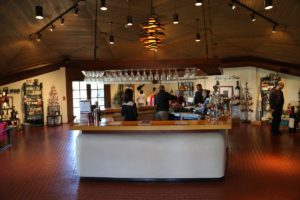
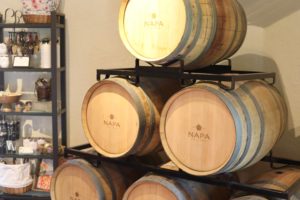 The 2021 Napa Cellars Napa Valley Merlot was aged for 18 months in 100% new French oak barrels of which 19% were new and 81% aged. It is medium to deep ruby in color; the bouquet delivers aromas of cherry pie, blackberry, raspberry, and boysenberry with additional scents of dried rose petals, mocha, old cedar wood, brown chocolate and coffee grinds. It is fully ripe but not over ripe and that is always an important distinction when describing characteristics of contemporary Napa Valley red wines. Bright, focused and balanced, the star of this show is its fruit. These flavors include blackberry, dark cherry, boysenberry and plum complemented by notes of chocolate, toffee and dried tobacco. Bright across the palate its lively acidity keeps this wine fresh. It finishes with grainy but already rounded tannins, three years post vintage. The tannins fully coat the entire palate with a light gripping character. This wine drinks great by itself but with food, possibly a lighter cut of steak, perhaps top sirloin. It is already drinking in a sweet post, three years post vintage.
The 2021 Napa Cellars Napa Valley Merlot was aged for 18 months in 100% new French oak barrels of which 19% were new and 81% aged. It is medium to deep ruby in color; the bouquet delivers aromas of cherry pie, blackberry, raspberry, and boysenberry with additional scents of dried rose petals, mocha, old cedar wood, brown chocolate and coffee grinds. It is fully ripe but not over ripe and that is always an important distinction when describing characteristics of contemporary Napa Valley red wines. Bright, focused and balanced, the star of this show is its fruit. These flavors include blackberry, dark cherry, boysenberry and plum complemented by notes of chocolate, toffee and dried tobacco. Bright across the palate its lively acidity keeps this wine fresh. It finishes with grainy but already rounded tannins, three years post vintage. The tannins fully coat the entire palate with a light gripping character. This wine drinks great by itself but with food, possibly a lighter cut of steak, perhaps top sirloin. It is already drinking in a sweet post, three years post vintage.
The 2021 Napa Cellars Napa Valley Cabernet Sauvignon is deep ruby and opaque; by any definition, this wine is not lacking for color. The wine was aged for 18 months in 100% French oak barrels of which 27% were new and 73% aged. The bouquet features scents of juicy blackberries, ripe Satsuma plums, boysenberry, dark cherry accompanied by nuances of dark chocolate, Graham cracker, mocha, old cedar and some baking spices including cinnamon and clove. It smells attractive. This is a lighter to medium bodied style wine from this variety; the palate offers flavors of blackberry, dark cherry, old cedar, tobacco, clove and mocha. The tannins are grainy and persist with a light drying grip and a note of white pepper. This is a balanced wine which is lifted by its bright and lingering acidity. Pair with lighter style meats such as flank steak and or BBQ chicken. It drinks well now but its window is open for another 5-8 years and possibly longer.
The 2018 Napa Cellars Winemaker Series Malbec is dark ruby with purplish tinges on the rim in the glass; the bouquet is opulent, open and expressive and features a dessert like quality based on both ripe fruit with a union of numerous secondary spices. It offers aromas of sweetly fruited mid summer ripe and juicy blackberry, dark cherry, boysenberry and mulberry along with milk chocolate, espresso, mocha and Graham Cracker. This bottling shows plenty of flavor including both red and darker fruits; it is somewhat brambly with flavors of cherry, currant and red plum. Finish with primarily red fruits, a darker spice note, juicy acidity and lightly textured rounded tannins with a lingering dried tobacco leaf quality. We had to really hunt for the alcohol listing on the label; its printed in white on the front label and is 13.9%.
The 2017 Napa Cellars Winemaker Series Petit Verdot is dark ruby in color and almost opaque in the glass; the bouquet is primarily focused on the fruit rather than aromatics as a result of barrel aging. The bouquet offers scents of dark plum and blackberry complemented by lighter nuances of dried herbs, dark pepper and deeper in the aromas, hints of mocha. The palate is mouthwatering, featuring a freshness and youthfulness carried by its bright acidity (we tasted 5 years post vintage). Offers flavors of blackberry, cherry and black currant. The finish is savory and tart, showing dark pepper, a juiciness and still tightly woven firm, dusty and dry tannins (but not texturally harsh) which continue to persist for some time. The grapes for this wine were primarily sourced from one site in Coombsville; after fermentation, the wine was aged in 100% French oak of which 44% was new for 23 months.
The 2015 Napa Cellars Zinfandel shows notes of tobacco smoke, cracked black pepper and spicy plum and dark cherry aromas on the bouquet. As it breathes, the aromatics become slightly floral. Shows a sweetness of fruit on the palate; this is a lighter style Zinfandel with bright acidity. The palate revels flavors of tart plum and other red fruits with light well-integrated tannins along with a lingering note of wood spice on the finish.
—
Want to relax outside? One can certainly do so, weather permitting. Napa Cellars is one of a limited number of Napa Valley wineries that legally allows guests to bring and eat food on site. In 2022 the backyard was redesigned slightly to incorporate more picnic tables. Sometimes a few lawn games are scattered around and are especially popular on summer and fall weekends. Music is piped outdoors. And you can see their tiny 3/4 of an acre estate Cabernet Sauvignon vineyard growing next to the lawn. The grounds are dog friendly. The vibe here is refreshingly casual; we need more of that in the valley.
While their permit does not allow them to serve wine outside, one can certainly bring a glass of wine and enjoy it outside. Wine club members can also order bottles and bring them outside.
And two restaurants, Brix and Mustards are within a very short drive from Napa Cellars, both among Napa Valley’s longest continuously operating restaurants.
Napa Cellars offers several wine club options. For more information, to purchase wine or to make an appointment to visit the tasting room, visit: www.napacellars.com

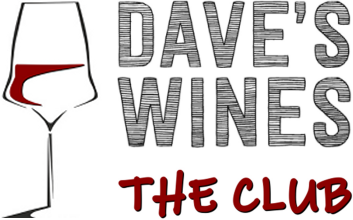





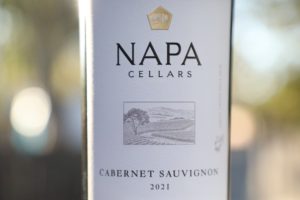
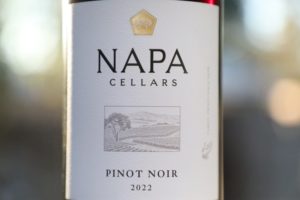
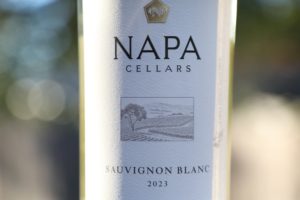
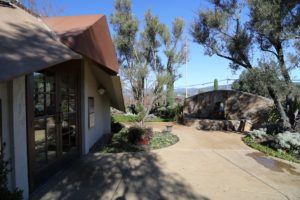
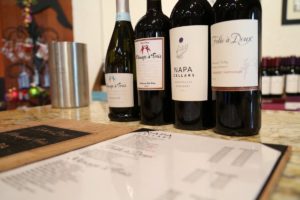
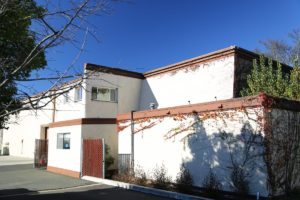
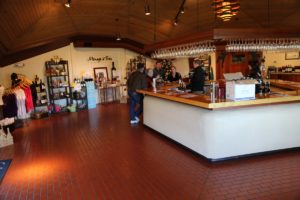
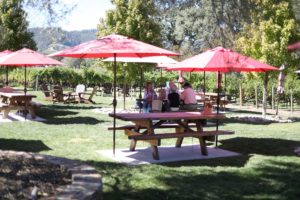
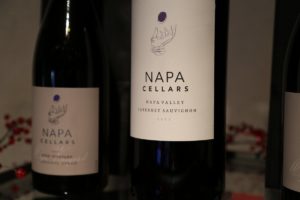
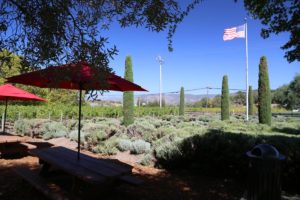
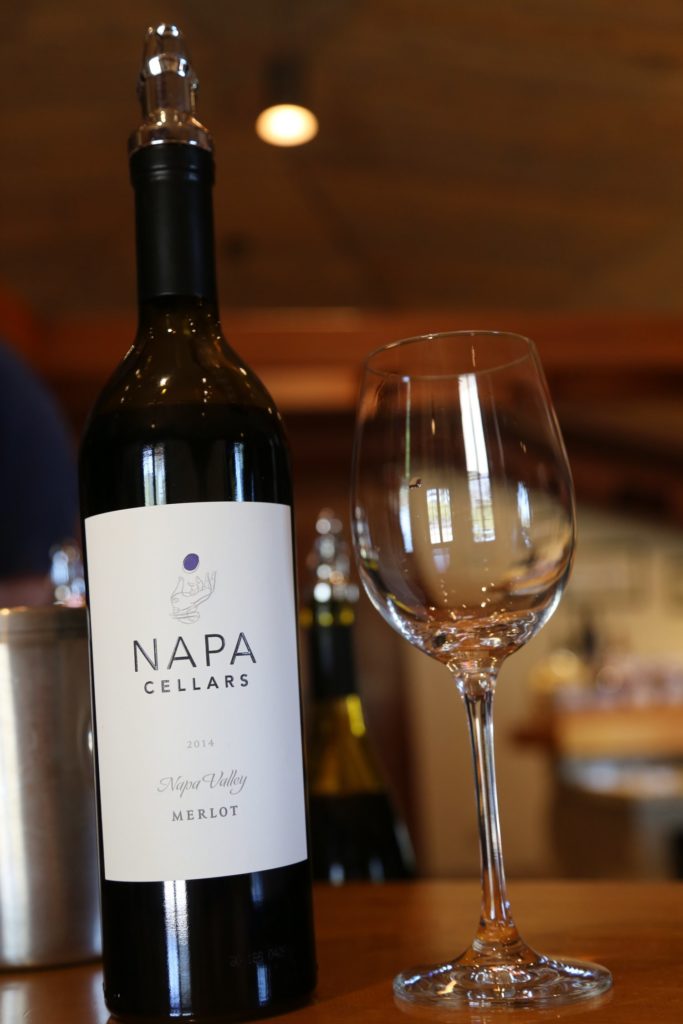
I have several bottles of DeMoor Cabernet Sauvignon with a vintage date of 1982, a year before the reported purchase of the winery by the Belgian family in 1983. Either the reported date of purchase of the winery is wrong, or the new owners bottled the wine from the vintage before their 1983 purchase and labeled it 1982.
The wine has been in my temperature controlled cellar since about 1998, and before that was in a cellar on Martha’s Vineyard. I bought it at an estate sale. It is in good condition, although it tastes like old wine, slightly brown, but definitely not spoiled. Would you like me to send you the labels?
If you want you can use email listed on our about us page to send images of the labels.
Wish you would’ve kept some of the fie dough from the 1990 era that was my first experience of dessert wine or where can I get some like that
I mean fie doux
Bill – thanks for the date mention. I did a little more research; ownership purchased the winery in 1983 and renamed it to DeMoor Winery & Vineyards. As you mentioned, I’m guessing they bottled the earlier vintage(s) at some point as DeMoor.
This profile has been one of the hardest to write over the years of all our Napa reviews, because of all the changes in ownership and name changes over the decades. In addition we have never been able to connect with anyone at the winery who really knows the history of the property. We have tried to reach out several times to their winemaking team. So we just pop by every now and then and purchase wines to update to our tasting notes on our profile here.
Irene – that is going back a ways. In 1990 they were selling 375 bottles of Fie Doux for $11 🙂 I suspect it might be hard to find some of those older vintages these days as they were probably mostly consumed back then.